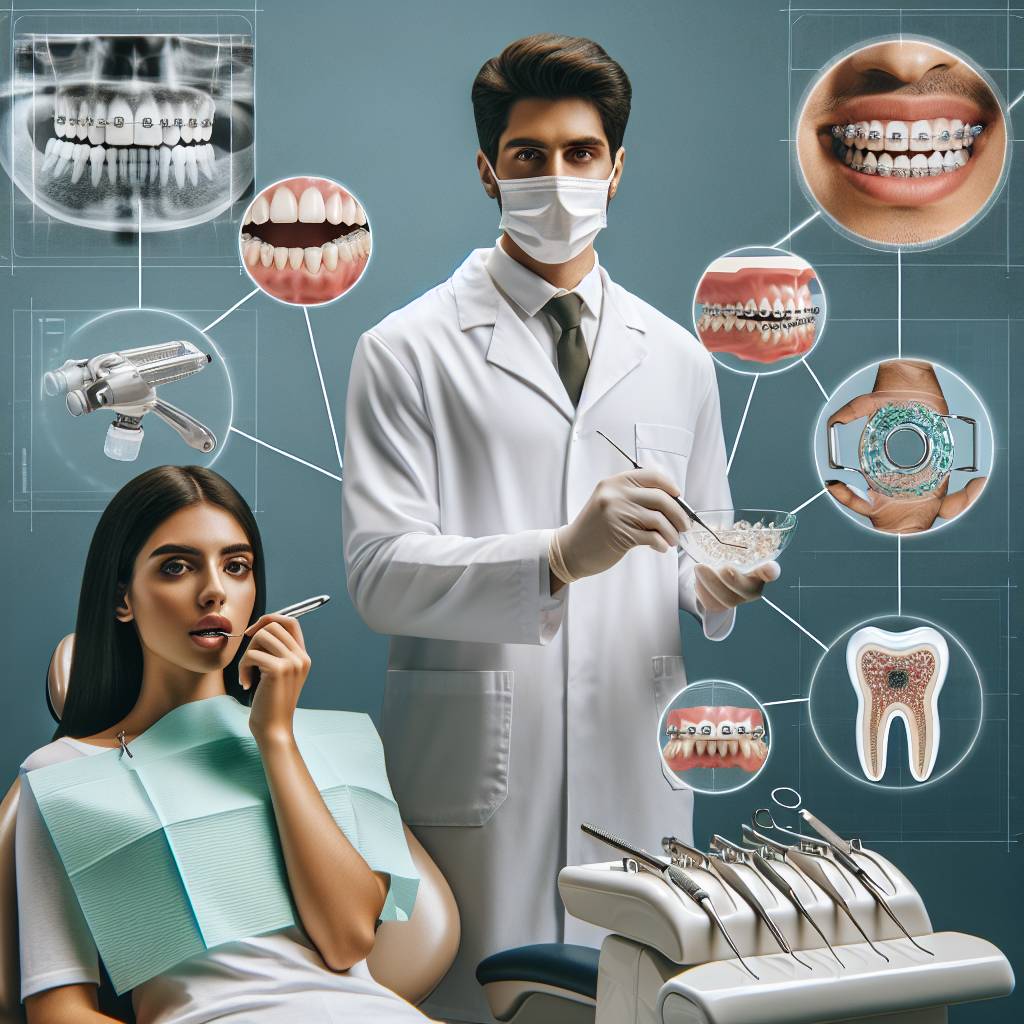Preventive Strategies for Teeth Movement
One of the best ways to prevent teeth movement is to practice good oral hygiene. Brushing and flossing regularly can help keep your teeth healthy and strong, as well as prevent plaque build-up. Additionally, regular visits to the dentist can be beneficial in catching any potential issues before they become a problem. Regular check-ups will allow your dentist to monitor your teeth and gums for any signs of shifting or movement.
Another important preventive strategy is to wear a mouthguard when participating in contact sports or activities that involve physical contact. A properly fitted mouthguard helps protect the teeth from trauma and can prevent them from shifting due to external forces. Additionally, it is important to avoid habits such as grinding or clenching your teeth, which can lead to excessive movement of the teeth over time.
In some cases, braces may be necessary in order to prevent further shifting of the teeth. Braces work by applying pressure on the teeth in order to move them into their correct positions and keep them there. Additionally, braces can help correct uneven bites, an overbite, or an underbite which could be contributing factors to excessive tooth movement.
Finally, dietary choices can have an impact on tooth movement as well. Eating sugary foods and drinks can lead to plaque build-up on the teeth which can cause enamel erosion and weakening of the surrounding structures that hold them in place. It is important to eat a balanced diet with plenty of fruits and vegetables that are rich in vitamins and minerals that help maintain healthy gums and bones which support your teeth structure.
Orthodontic Treatments to Stop Teeth Movement
Orthodontics is a branch of dentistry that specializes in the prevention and correction of malocclusions, or misaligned teeth and jaws. Orthodontic treatments are used to stop teeth movement and improve the alignment of the teeth and jaws. These treatments involve the use of braces, retainers, or other appliances to gradually move the teeth into their proper position. Orthodontic treatments can also prevent further tooth movement from occurring, as well as help restore the bite and correct any facial irregularities caused by misalignment.
Braces are one of the most common orthodontic treatments used to stop teeth movement. Braces utilize brackets and wires to slowly move the teeth into their proper position over time. The braces are attached to each tooth with small bands that are tightened periodically throughout treatment. This gradual force causes the teeth to shift into their desired position over time.
Retainers may also be used to stop tooth movement and keep them in place once they have been moved into alignment with braces. Retainers are typically worn at night or for short periods of time during the day, depending on your orthodontist’s instructions. They hold your teeth in place while allowing them to adjust to their new positions without any further movement.
In some cases, surgery may be necessary to stop tooth movement and restore alignment. Surgery is typically reserved for extreme cases where traditional orthodontic treatments have not been successful or when there is an abnormality present that needs medical attention. Surgery may involve removing a portion of bone in order to realign the bones and jaw joint, or it may involve repositioning one or more teeth with special instruments called forceps.
No matter what type of orthodontic treatment you need, it is important that you visit an experienced orthodontist who can help you determine which treatment option will best meet your needs and provide you with long-term results that will keep your smile healthy for years to come!
Benefits of Orthodontic Treatment for Stopping Teeth Movement
Orthodontic treatment is a great way to stop the movement of teeth and ensure that your teeth remain in their natural alignment. By using orthodontic braces, retainers and other appliances, it is possible to hold your teeth in place and reduce the risk of further movement. This can help to prevent the need for more costly and invasive treatments such as dental implants or veneers. In addition, orthodontic treatment can improve your overall oral health by helping to reduce plaque buildup, reduce the risk of gum disease, and improve the appearance of your smile.
The main benefit of orthodontic treatment is that it helps to stop teeth from moving out of alignment. This can help prevent further damage to your teeth or jawbone caused by misaligned teeth. Orthodontic treatment also helps correct an overbite or underbite, which can make it difficult to bite and chew properly. It can also correct overcrowding or spacing between teeth, which can lead to cavities or gum disease if left untreated. Finally, orthodontic treatment helps to improve the overall appearance of your smile by straightening crooked or misaligned teeth.
Another benefit of orthodontic treatment is that it can help you maintain good oral hygiene habits. Proper brushing and flossing are essential for keeping your mouth healthy, but if you have misaligned teeth it may be difficult to reach all areas in between your teeth without braces or other appliances. Wearing braces or other appliances makes it easier to brush and floss all areas in between your teeth so you can maintain a healthy mouth.
Finally, orthodontic treatment also helps improve self-esteem by improving the appearance of your smile. When you have straight, well-aligned teeth you feel more confident about smiling and speaking in public. So not only does orthodontic treatment help protect the health of your mouth but it also has psychological benefits too!

Types of Braces Used to Stop Teeth Movement
Braces are often used to help straighten and properly align teeth. They can also be used to keep teeth in position after they have been moved by orthodontic treatment. Braces can be made of metal, ceramic, or plastic and come in a variety of types. The type of brace that is used will depend on the specific condition being treated.
Metal braces are the most common type of braces and are typically made from stainless steel or titanium. They consist of brackets that are attached to the teeth, and an archwire that runs through them. These wires can be adjusted to help move the teeth into the desired position. Patients may also need to wear elastic bands and headgear to help keep their teeth in place during treatment.
Ceramic braces are similar to metal braces, but they use clear or tooth-colored brackets instead of metal ones. This makes them less visible than traditional braces, which may be more appealing for some patients. However, they tend to be more fragile than other types and may require more frequent adjustments than metal braces do.
Lingual braces use brackets that are placed on the back side of the teeth rather than on the front side like traditional braces do. This makes them much less visible than other types, but they can be difficult for some people to get used to because they make it harder to speak clearly. They may also take longer for patients to adjust to and require more frequent adjustments than other types of braces do.
Invisalign is a type of clear aligner system that does not use any metal or ceramic components like traditional braces do. Instead, it uses sets of clear trays that fit over the patient’s teeth and gradually shift them into place over time without having any visible components on the outside of the mouth. Invisalign is becoming increasingly popular because it is much less noticeable than other types of braces and requires fewer visits for adjustments, but it tends to be more expensive than other types as well.
No matter which type of brace is used, patients should follow their orthodontist’s instructions carefully in order for treatment to be successful. Regular checkups with an orthodontist will also help ensure that treatment is progressing as planned and that any necessary adjustments are made in a timely manner.
Pros and Cons of Different Types of Braces
Braces are a common orthodontic treatment used to correct misaligned teeth and improve overall oral health. While traditional metal braces have been around for decades, there are now many different types of braces available, each with their own unique advantages and disadvantages. Below is a breakdown of the pros and cons of different types of braces.
Metal Braces
Metal braces are the most common type of orthodontic treatment, and the most affordable option. Metal braces consist of brackets mounted onto the patient’s teeth with an archwire running through the brackets. Metal braces are extremely durable and can be adjusted to provide precise results. The main disadvantage of metal braces is that they can be uncomfortable or painful at times, as well as being noticeable due to their appearance.
Ceramic Braces
Ceramic braces are made from clear materials and designed to blend in with the color of your teeth, making them less visible than traditional metal braces. Ceramic braces work in much the same way as metal ones, but they require more careful dental hygiene habits as they can discolor easily if not taken care of properly. They also tend to be more fragile than metal braces, so they may need to be replaced more often.
Lingual Braces
Lingual braces are similar to traditional metal braces but instead of being placed on the front side of your teeth, they are placed on the back side which makes them nearly invisible from a distance. Lingual braces can be customized for each patient’s needs and provide excellent results, however they can be difficult to adjust which can cause discomfort or pain during treatment. They also require extra time during appointments since each bracket has to be adjusted individually.
Invisalign®
Invisalign® is an increasingly popular orthodontic treatment that uses a series of custom-made aligners made from clear plastic instead of traditional brackets and wires. The aligners fit snugly over your teeth and gradually move them into place without being noticeable while you wear them. Invisalign® allows for greater comfort than other types of braces as there are no wires or brackets involved, however it usually costs more than traditional treatments due to its custom nature and longer overall treatment time.
How Long Does It Take for Braces to Stop Teeth Movement?
Braces are one of the most common orthodontic treatments used to correct misaligned teeth and improve the overall appearance of the smile. But how long does it take for braces to stop teeth movement? The answer depends on the severity of the misalignment and the type of braces being used. In general, most people can expect their braces to stop teeth movement within six months to a year.
The duration of treatment with braces can vary greatly depending on how much movement is needed in order to correct the misalignment. If only minor adjustments are required, then treatment may only take a few months. However, if more significant changes need to be made, treatment can take up to two years or more.
In addition, certain types of braces are faster at correcting misalignment than others. For instance, conventional metal braces tend to be slower than ceramic or lingual braces (which go behind the teeth). Some orthodontists also offer accelerated treatments such as clear aligners or “invisalign” which can speed up treatment time significantly.
It is important to keep in mind that while braces can stop teeth movement relatively quickly, they are not a permanent solution. Once the braces are removed, patients will need to wear retainers in order to maintain their newly aligned smile. Wearing retainers as prescribed by your orthodontist is essential in order to prevent any further misalignment from occurring after treatment has been completed.

Conclusion
Maintaining healthy teeth is essential for overall health and well-being. It’s important to take the steps necessary to ensure that your teeth remain in their proper positions and aren’t shifting. If you see that your teeth are moving, it’s best to consult with a dentist right away so they can identify the underlying cause and provide guidance on how to proceed. There are a variety of treatments available depending on the severity of the problem, ranging from simple orthodontic appliances like retainers to more complex dental surgeries.
No matter what, be sure to practice good oral hygiene habits such as brushing twice daily and flossing every day. Additionally, maintain regular dental appointments with your dentist so they can monitor for any changes in your smile or signs of gum disease or other oral health problems. With a bit of effort and diligence, you can keep your teeth in place for life.

